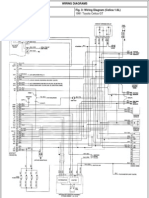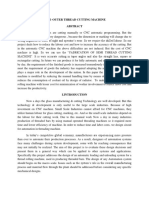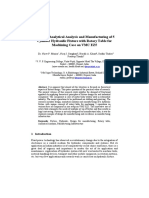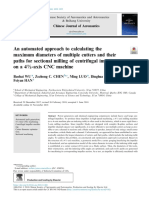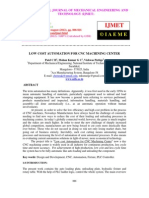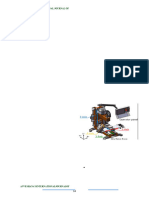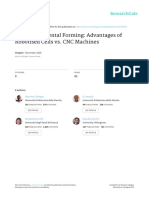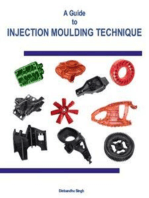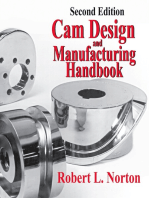Samuthra Projects PDF
Samuthra Projects PDF
Uploaded by
sageetha756Copyright:
Available Formats
Samuthra Projects PDF
Samuthra Projects PDF
Uploaded by
sageetha756Original Title
Copyright
Available Formats
Share this document
Did you find this document useful?
Is this content inappropriate?
Copyright:
Available Formats
Samuthra Projects PDF
Samuthra Projects PDF
Uploaded by
sageetha756Copyright:
Available Formats
International Journal of Modern Studies in Mechanical Engineering (IJMSME)
Volume 3, Issue 3, 2017, PP 40-48
ISSN 2454-9711 (Online)
DOI: http://dx.doi.org/10.20431/2454-9711.0303005
www.arcjournals.org
A Dual Side Shaping Machine for Industrial Applications
Dr. M. K. Marichelvam1, Mr. K.Kandakodeeswaran2
1,2
Department of Mechanical Engineering, Mepco Schlenk Engineering College,
Sivakasi, Tamilnadu, India
*Corresponding Author: Dr. M. K. Marichelvam, Department of Mechanical Engineering, Mepco
Schlenk Engineering College, Sivakasi, Tamilnadu, India
Sivakasi,
Abstract: Most of the industries are having a Tamilnadu, India
various types of reciprocating machines for performing
machine operation on small size of work. Usually shaper, broaching machine and planner are used for
machining a small area of work with less quantity. These machines are used for machining very small area of
plain surface, vertical surface, angular surface, grooving etc. It removes the materials from job only at
forward stroke. So it takes more machining time to complete the product. In order to overcome this problem,
a small dual shaper machine is developed for machining two work pieces at a same time. In this machine, it
has both the direction of ram movement and it removes a material from two work pieces simultaneously. So,
the machining time will be reduced and the production rate will be increased.
Keywords: shaper, dual side shaper, machining Centre
1. INTRODUCTION
In general, the shaper can produce any surface composed of straight line elements. Modern shapers
can generate contoured surface. The main purpose of shaping machine is to machine plain horizontal
surface. It is possible to from vertical and angular surfaces also. With proper tools and accessories
even irregular surfaces can be formed. As per the of motion of the shaper they are
Crank type
Geared type
Hydraulic type
By moving the work piece across the path of the reciprocating tool a flat surfaces is generated
regardless of the shape of the tool. With the special tools, attachments and devices for holding the
work, a shaper can also be used to cut external and internal keyways, gears, racks, dovetails, T-slots
and other miscellaneous shapes. Shaping is essentially an inefficient method of metal removal but the
simplicity of the process coupled with short set up time and cheap tooling makes it extremely useful
for the single job.
The most common type of horizontal shapers is the production push cut shaper. This type of shaper
consists of a frame or column supported on a base, a reciprocating ram and work table. The frame
houses the drive mechanism of the shaper. The tool slide swivel base is held on the circular seat on
the ram and is graduated to indicate the angle of swivel. The apron consisting of the clapper box the
clapper block and the tool post is clamped on the vertical slide by a screw. It can be swiveled about
the apron swivel in by releasing the clamping screw. The clapper blocks which carries the tool post is
connected to the clapper box means of a hinged pin. The researchers suggested that a shaping machine
for dividing a deformable mass, such as a meat product, into separately shaped portions comprises a
stock container, at least two piston-cylinder units for alternately feeding in the mass from the stock
container to a shaping plate provided with shaped recesses, and also means for removing the shaped
portions from the shaping plate [1].
Some authors suggested that twin mounted double sided reciprocating shaping mechanism is provided
which is formed in the shape of an acute isosceles triangle whereby the bottom is opened to the
ground and each cutting mechanism is bent or deformed along the longitudinal axis to form to a
International Journal of Modern Studies in Mechanical Engineering (IJMSME) Page | 40
A Dual Side Shaping Machine for Industrial Applications
conical shape when rotated about the center axis of the isosceles triangle. The twin mounted double
sided reciprocating shaping mechanism is adapted to be used for cutting and shaping and forming
trees, bushes and the like in the contour of a cone [2].
The invention relates to a machine for cutting down and shaping trees, designed to cut down, strip and
truncate trees, consisting of a support and cutting down-stripping-truncating equipment likely to be
adapted to a self-propelling device, said equipment carrying a movable framework on which the
cutting-truncating and stripping elements are positioned, a machine wherein the components there of
are substantially secured along a one and same axis, the stripping element carrying at least two blades
is explained in [3].This invention relates to improvements in machines for building pneumatic tires
[4]. It includes features which are beneficial in the building of almost any standard type of pneumatic
tire, although it is most particularly suited to the fabrication of radial ply tires. In the manufacture of
radial ply tires, comprised of single or multiple plies composed of wire and/or textile, it is
conventional practice to wind the rubberized ply or plies on a revolving cylindrical tire building drum
with the wires or cords forming high angles.
Some authors suggested that multi-touch capacitive touch sensor panel can be created using a
substrate with column and row traces formed on either side of the substrate. To shield the column
(sense) traces from the effects of capacitive coupling from a modulated Vcom layer in an adjacent
liquid crystal display (LCD) or any source of capacitive coupling, the row traces can be widened to
shield the column traces, and the row traces can be placed closer to the LCD [5].Tire shaping machine
invention relates to improvements in machines for building pneumatic tires [6]. It includes features
which are beneficial in the building of almost any standard type of pneumatic tire, although it is most
particularly suited to the fabrication of radial ply tires.
In the manufacture of radial ply tires, comprised of single or multiple plies composed of wire and/or
textile, it is conventional practice to wind the rubberized ply or plies on a revolving cylindrical tire
building drum with the wires or cords forming high angles (in the neighborhood of 90) to a plane that
is perpendicular to the finished tire axis. The opposite ends of the ply or plies are each then folded
around a rubberized bead wire, and sidewall and under breaker stock are added. The semi-completed
carcass is then removed from the tire building drum and placed on a shaping machine (or,
alternatively, the carcass may have originally been built on a shaping machine drum), wherein a low
angle wire breaker strip (or circumferential restraining ply) and a tread slab are added thereto, and the
tire is brought to its ultimate shape is explained in [7].The application of the breaker strip or strips to
the semi-completed tire carcass is a critical step in the fabrication of a tire. It requires that the
circumference of the tire carcass be extended to the precise diameter at which this component is to be
added is explained in [8]. Normally in the manufacturing industry the shaping machine is used to
manufacture a component, the time consumption is more, if single tool is used to manufacture the
component. In order to reduce the time taken to produce a component, a new type of shaper machine
was developed. In this new type of machine two shaping tools are used. Therefore two work pieces
can be machined at the same time. In dual side shaper machine the machining time will be less when
to normal shaper. The power consumption is same in both the shaper machine, and the speed of the
ram will be controlled.
2. DESIGN CALCULATIONS OF THE COMPONENTS
The components used in the dual side shaper machine are
Frame
Pulley
Single Phase Induction Motor
V-Belt
Shaft
Roller Bearing
Shaping Tool
2.1. V -Belt Design Calculation
Large pulley diameter = 30cm = 300mm
International Journal of Modern Studies in Mechanical Engineering (IJMSME) Page | 41
A Dual Side Shaping Machine for Industrial Applications
Small pulley diameter =4cm =40mm
Belt width = 38.5cm =385mm
Power =100W
Speed of motor =1300 rpm
Rated power =150T
2.1.1. Selection of the V Belt
From PSG data book for 100W, A section belt is chosen.
2.1.2. Selection of Pulley Diameter
I=D/d=N/n
7.5=N/n n=1300/7.5=173.33
Recommended minimum diameter d=75 mm
I=300/40 = 7.5mm
Recommended C/D ratio =0.85
2.1.3. Calculation Pitch Length
From PSG data book page no 7.61
L= 2c+ /2(D+d)+
C=385mm
=0.85
C=0.85*300=255 mm
C=255mm
L= 2*385+ /2(300+40)+
L=1347.96mm
Standard length L= 2703 mm
2.1.4. Calculation of Maximum Power Capacity
A KW= ( -0.765* )s*125
=2.72m/s
A KW= ( -0.765* )2.72*125
A KW=0.49KW
2.1.5. Calculation of Arc of Contact
α
α
=139.48 degree
Correction factor Fd =0.89
Normal torque at 16hrs
Fa=1.3
Fc= 0.94
2.1.6. Calculation of Number of Belt
Number of belt =
International Journal of Modern Studies in Mechanical Engineering (IJMSME) Page | 42
A Dual Side Shaping Machine for Industrial Applications
=
= 0.3 1
Number of belt = 1belt
2.1.7. Calculation of Actual Length
Standard Length (L) = 2703mm
A )
)
A =542.25mm
B= =
=8450mm
C = A+
=542.25+
C=1076.90mm
3. MODELING OF MACHINE AND MACHINE COMPONENTS
The 3-D modeling of machine and the components is carried out in Solid Works software. The
modeling application also provides “features based” solid bodies by directing editing capabilities,
which allow changing and updating solid bodies by directing editing the dimensions of a solid feature
or by other geometric construction techniques.
3.1. Parts to be Designed
The various parts to be designed in solid works software are
Shaft
Pulley
Work table
Angle
Ram
Work piece
3.2. Isometric View of Dual Shaper
The isometric view of dual shaper machine is illustrated in Figure 1
Figure1. Isometric View of Dual Shaper
International Journal of Modern Studies in Mechanical Engineering (IJMSME) Page | 43
A Dual Side Shaping Machine for Industrial Applications
3.3. Pulley
The modelling of pulley is depicted in Figure 2. The pulley material used here is cast iron.
Figure2. Isometric View of Pulley
3.4. Table
The isometric view of table is depicted in Figure 3.
Figure3. Isometric View of Table
3.5. Shaft
The isometric view of shaft is shown in Figure 4.
Figure4. Isometric View of Shaft
International Journal of Modern Studies in Mechanical Engineering (IJMSME) Page | 44
A Dual Side Shaping Machine for Industrial Applications
3.6. Wheel
The isometric view of wheel is shown in Figure 5.
Figure5. Isometric View of Wheel
3.7. Ram
The isometric view of ram is depicted in Figure 6.
Figure6. Isometric View of Ram
4. LAYOUT OF THE MACHINE AND MECHANISMS USED
The components (or) parts are assembled and the machining process is carried out. The fabrication of
dual side shaper machine is clearly shown in figure 7.
Figure7. Layout of the dual side shaper machine
International Journal of Modern Studies in Mechanical Engineering (IJMSME) Page | 45
A Dual Side Shaping Machine for Industrial Applications
4.1. Mechanisms Used in Dual Shaper
The mechanism used in the dual shaper is explained below.
4.1.1. Scotch Yoke Mechanism
The Scotch yoke (also known as slotted link mechanism) is a reciprocating motion mechanism,
converting the linear motion of a slider into rotational motion or vice versa. The piston or other
reciprocating part is directly coupled to a sliding yoke with a slot that engages a pin on the rotating
part. The location of the piston versus time is a sine wave of constant amplitude, and constant
frequency given a constant rotational speed. This mechanism is generally found on shaping machines
where single point cutting tool is mounted on the front of the slider or ram, in a hinged tool post. The
tool cuts on the slow forward stroke and lifts over the work piece on the quick return stroke. The
slotted link rocks from side to side, driven by the sliding block on the bull wheel. The various views
of the proposed dual shaper machine is shown in below figures 8-10.
Figure8. Front View of Dual Shaper
Figure9. Top View of Dual Shaper
International Journal of Modern Studies in Mechanical Engineering (IJMSME) Page | 46
A Dual Side Shaping Machine for Industrial Applications
Figure10. Side View of Dual Shaper
4.2. Machining Time Calculation
Length of the cutting stroke = 50 mm
Time required by cutting stroke = 2 sec
Cutting speed = 25mm/sec
Plate size = 20*20*20
Total length of stroke = 20+20
= 40mm
Cutting time for single work piece = 40/25
=1.6sec
This dual shaper return time = 1.6/2
= 0.8sec
Total time = 2.4sec
Total number of stroke necessary to complete the cut = 40/2
= 20 mm
Total time required to complete the cut = 2.4*20/60
= 0.8min
International Journal of Modern Studies in Mechanical Engineering (IJMSME) Page | 47
A Dual Side Shaping Machine for Industrial Applications
5. CONCLUSIONS AND FUTURE RESEARCH
In this paper, a dual side shaper is designed and fabricated. This dual side shaper machine is used to
manufacture components similar to a standard shaper machine. However, the machining time required
for this dual shaper is less as compared to the normal shaper. Hence, the production rate is increased
in the dual side shaper machine when compared to the normal shaper. The designed dual shaper has
been used for only trial production. In the future it would be used for commercial production in
industries.
REFERENCES
[1] Hnatovsky, C., Shvedov, V. G., Shostka, N., Rode, A. V., & Krolikowski, W. (2012). Polarization-
dependent ablation of silicon using tightly focused femtosecond laser vortex pulses. Optics Letters, 37(2),
226-228.
[2] D.M. Karnakis, J. Fieret, P.T. Rumsby, M.C. Gower, shaping using reshaped pulsed Gaussian laser beams,
in: Proceedings of SPIE, vol. 4443, 2001.
[3] "Cigar bunch shaper mechanism." U.S. Patent 2,102,298, issued December 14, 1937.
[4] Safdar, S., Li, L., Sheikh, M. A., & Liu, Z. (2007). Finite element simulation of laser tube bending: Effect
of scanning schemes on bending angle, distortions and stress distribution. Optics & Laser Technology,
39(6), 1101-1110.
[5] SP Hotelling, BR Land (2011) ‘DUAL SHAPER’- US patent7,920,129.
[6] KR Lessard, JM McElrathJr (1983) ‘DOUBLE SIDE RECIPROCATING SHAPER’-US Patent 4,383,401.
[7] T.V. Sundararajamoorthy and N. Shanmugam (1982) ‘MACHINE DESIGN’, Anuratha Publications,
Chennai, India.
[8] Khurmi,R.S and Gupta, J.K.(1997) ‘A TEXTBOOK OF MACHINE DESIGN’, S. Chand Publications,
New Delhi, India.
AUTHORS’ BIOGRAPHY
M. K. Marichelvam, received his B.E. degree in Mechanical Engineering from
Madurai Kamaraj University, Madurai, India, in 2000. He has obtained a Masters
in Engineering in Industrial Engineering from Madurai Kamaraj University,
Madurai, India, in 2002. He has obtained Ph.D. in Mechanical Engineering from
Anna University, Chennai, India in 2015. He is currently working as Assistant
Professor (Sr. Grade) in Mechanical Engineering Department, Mepco Schlenk
Engineering College, Sivakasi, India. His active areas of interests are
Manufacturing Scheduling, Multi-objective optimization, Industrial and Production
Management and optimization techniques. He has published many research papers in the Journals of
International repute. He has presented papers at several international conferences.
K. Kandakodeeswaran, received his B.E. degree in Mechanical Engineering
from Anna University, Chennai, India, in 2012. He obtained Master degree in
Computer Integrated Manufacturing from Anna University, Chennai, India, in
2014. He is currently working as an Assistant Professor in Mechanical
Engineering Department, Mepco Schlenk Engineering College, Sivakasi, India.
His areas of interests are Design and Manufacturing. He has published a research
papers in the Journals of International repute. He has presented papers at some
national conferences.
Citation: Dr. M. K. Marichelvam & Mr. K. Kandakodeeswaran (2017). A Dual Side Shaping Machine for
Industrial Applications, International Journal of Modern Studies in Mechanical Engineering (IJMSME),
3(3), pp.40-48, DOI: http://dx.doi.org/10.20431/2454-9711.0303005.
Copyright: © 2017 Dr. M. K. Marichelvam & Mr. K. Kandakodeeswaran This is an open-access article
distributed under the terms of the Creative Commons Attribution License, which permits unrestricted use,
distribution, and reproduction in any medium, provided the original author and source are credited
International Journal of Modern Studies in Mechanical Engineering (IJMSME) Page | 48
You might also like
- Isuzu 07TF Immobilizer Training Ver1Document50 pagesIsuzu 07TF Immobilizer Training Ver1Teddy KhantNo ratings yet
- Internship Report-Template-III Semester - 2020-2022 BATCHDocument20 pagesInternship Report-Template-III Semester - 2020-2022 BATCHsageetha75686% (7)
- HP4000 Parts ManualDocument6 pagesHP4000 Parts ManualRamona Andreea AparaschiveiNo ratings yet
- Thesis - Self Balancing RobotDocument76 pagesThesis - Self Balancing RobotEcho Alex90% (10)
- Komatsu Wheel Loader Wa380 6 Operation and Maintenance ManualDocument20 pagesKomatsu Wheel Loader Wa380 6 Operation and Maintenance Manualreva100% (59)
- VPM1023 Design and Fabrication of Crop Cutting Machine Lokesh 6383867690Document2 pagesVPM1023 Design and Fabrication of Crop Cutting Machine Lokesh 6383867690sageetha756100% (1)
- XL4300II Parts ManualDocument440 pagesXL4300II Parts ManualАлексей100% (1)
- PDF - Putzmeister-PlacingBoomDocument40 pagesPDF - Putzmeister-PlacingBoomcriman45No ratings yet
- 1.development of Self Charging Dynamo and Solar Powered Based TricycleDocument100 pages1.development of Self Charging Dynamo and Solar Powered Based TricycleSRL MECHNo ratings yet
- 4a FeDocument16 pages4a FeJohn Simmonds78% (18)
- Duel Side Sapher PDFDocument9 pagesDuel Side Sapher PDFsageetha756No ratings yet
- Scotch Yoke MechanismDocument53 pagesScotch Yoke Mechanismhellohoney143341No ratings yet
- Cad by BiomedicalDocument20 pagesCad by BiomedicalAshish RajNo ratings yet
- Semi - Outer Thread Cutting MachineDocument4 pagesSemi - Outer Thread Cutting MachineTechnico TechnocratsNo ratings yet
- Use of Mechatronic System To Manufacture Spiral Bevel Gear Using 3-Axis CNC Milling MachineDocument5 pagesUse of Mechatronic System To Manufacture Spiral Bevel Gear Using 3-Axis CNC Milling MachinetuongnvNo ratings yet
- Machine Tool Design Lab ManualDocument40 pagesMachine Tool Design Lab ManualRohitGupta100% (2)
- Machine Tool Design Lab ManualDocument40 pagesMachine Tool Design Lab ManualRohitGupta100% (1)
- Multi Operation Machine Using Scotch Yoke MechanismDocument65 pagesMulti Operation Machine Using Scotch Yoke MechanismCrispNo ratings yet
- Icram19 10 01 19 06 10 57 ModifiedDocument7 pagesIcram19 10 01 19 06 10 57 ModifiedAjit ParwaniNo ratings yet
- 3455 PDF PDFDocument6 pages3455 PDF PDFrezNo ratings yet
- Design and Fabrication of Multi Operational Material Removal MachineDocument3 pagesDesign and Fabrication of Multi Operational Material Removal MachineDHAMOTHARAKUMARNo ratings yet
- CNC 5 AxisDocument3 pagesCNC 5 AxisJonathan CharanrajNo ratings yet
- Cam Operated Reciprocating ViceDocument46 pagesCam Operated Reciprocating ViceseaNo ratings yet
- New Microsoft Office Word DocumentDocument10 pagesNew Microsoft Office Word DocumentKamaljeetNo ratings yet
- 1 s2.0 S0307904X1300379X MainDocument10 pages1 s2.0 S0307904X1300379X MainPradita FirmansyahNo ratings yet
- Ieee Chapter 2Document7 pagesIeee Chapter 2Apple DocasaoNo ratings yet
- Multi SpindleDocument10 pagesMulti Spindlearunurs1No ratings yet
- Executive SummaryDocument11 pagesExecutive SummaryNitish Kumar SinghNo ratings yet
- 417ijarseDocument7 pages417ijarsekumaran mNo ratings yet
- Sckotch Yoke MechanismDocument5 pagesSckotch Yoke MechanismShubham Magdum100% (1)
- Designing and Fabrication of Multipurpose Tool Post For Lathe MachineDocument3 pagesDesigning and Fabrication of Multipurpose Tool Post For Lathe MachineRahul ShrivastavaNo ratings yet
- Design & Development of Multipurpose Machine: Prof. S.S.Lande, Shrishiel Desai, Chetan JadhavDocument7 pagesDesign & Development of Multipurpose Machine: Prof. S.S.Lande, Shrishiel Desai, Chetan JadhavAung Khin ZawNo ratings yet
- Tool Path Optimization of Contouring Operation and Machining Strategies For Turbo Machinery BladesDocument7 pagesTool Path Optimization of Contouring Operation and Machining Strategies For Turbo Machinery BladesseventhsensegroupNo ratings yet
- TSP Iasc 19274Document12 pagesTSP Iasc 19274IbrahimNo ratings yet
- Design and Fabrication of Square Hole Drilling MachineDocument6 pagesDesign and Fabrication of Square Hole Drilling MachineAjay SataoNo ratings yet
- Design and Modification of Bench Vice by Increasing The Degrees of FreedomDocument4 pagesDesign and Modification of Bench Vice by Increasing The Degrees of FreedomGRD JournalsNo ratings yet
- IJRTI2305025Document4 pagesIJRTI2305025anupkale630No ratings yet
- IJRPR14264Document4 pagesIJRPR14264maghadheera2004No ratings yet
- Jaw Crusher Kinematics Simulation and AnalysisDocument5 pagesJaw Crusher Kinematics Simulation and AnalysisInternational Journal of Research in Engineering and ScienceNo ratings yet
- Multiple Angle Pipe Bending MachineDocument99 pagesMultiple Angle Pipe Bending MachineselvarajNo ratings yet
- Ijert Ijert: K.Sunitha & CH - Srinivas RaoDocument4 pagesIjert Ijert: K.Sunitha & CH - Srinivas RaoAbdullah AlrajhyNo ratings yet
- Use of PLC Module To Control A Rotary TaDocument9 pagesUse of PLC Module To Control A Rotary TaΠερικλής ΖυγούραςNo ratings yet
- Design and Analysis of A 5-Axis Gantry CNC MachineDocument6 pagesDesign and Analysis of A 5-Axis Gantry CNC MachineBorodiAdrianNo ratings yet
- 1 s2.0 S1000936118303571 MainDocument10 pages1 s2.0 S1000936118303571 MaininakiNo ratings yet
- CNCLATHEDocument13 pagesCNCLATHEMuhd Akmal0% (1)
- Fully Automatic Can Crusher-1280Document5 pagesFully Automatic Can Crusher-1280fadya100% (1)
- Tool Path Optimization of Contouring Operation and Machining Strategies For Turbo Machinery BladesDocument8 pagesTool Path Optimization of Contouring Operation and Machining Strategies For Turbo Machinery BladesODEH ABU YAHIANo ratings yet
- Abrasive Cut Off Machine Mini ProjectDocument49 pagesAbrasive Cut Off Machine Mini ProjectdurendranNo ratings yet
- Design and Fabrication of Multi-Purpose Sieving MachineDocument6 pagesDesign and Fabrication of Multi-Purpose Sieving MachineMICHEL RAJ MechNo ratings yet
- Key Words: Cutting Mechanism EtcDocument5 pagesKey Words: Cutting Mechanism EtcHarshal PatilNo ratings yet
- Hydraulic Rivet Proposal PDFDocument12 pagesHydraulic Rivet Proposal PDFlet it beNo ratings yet
- 6.intro To Photo of Dual Side Shaper Using Scotch Yoke MechanismDocument36 pages6.intro To Photo of Dual Side Shaper Using Scotch Yoke Mechanismvijay vijay33% (3)
- Low Cost Automation For CNC Machining Center PDFDocument11 pagesLow Cost Automation For CNC Machining Center PDFgsudhanta1604No ratings yet
- Power HacksawDocument30 pagesPower Hacksawbilal shaikh100% (4)
- Design and Static Analysis of A Tool For Four Axis Milling Machine 1Document6 pagesDesign and Static Analysis of A Tool For Four Axis Milling Machine 1murat aydoganNo ratings yet
- DESIGN AND FABRICATION OF SQUARE HOLE DRILLING MACHINE (1) - Converted (1) .IjaritDocument6 pagesDESIGN AND FABRICATION OF SQUARE HOLE DRILLING MACHINE (1) - Converted (1) .IjaritChiranjeev SethiNo ratings yet
- Ever Green MachinesDocument6 pagesEver Green MachinesLisa ParksNo ratings yet
- Proto Copy Finale DraeteDocument60 pagesProto Copy Finale DraeteAjinkya MoreNo ratings yet
- Metal SpinningDocument4 pagesMetal SpinningfranklynNo ratings yet
- Project Report VajDocument15 pagesProject Report VajTamil SelvanNo ratings yet
- Design and Analysis of Drum Lathe For Manufacturing Large-Scale Optical Microstructured Surface and Load Characteristics of Aerostatic SpindleDocument6 pagesDesign and Analysis of Drum Lathe For Manufacturing Large-Scale Optical Microstructured Surface and Load Characteristics of Aerostatic SpindleN. P. JAGANNo ratings yet
- Sloting MachineDocument5 pagesSloting MachinePatel NikhilNo ratings yet
- Sheet Incremental Forming: Advantages of Robotised Cells vs. CNC MachinesDocument23 pagesSheet Incremental Forming: Advantages of Robotised Cells vs. CNC MachinesManolo GipielaNo ratings yet
- 018 Fab Indexing Table For Vertical Milling 2010MCDocument40 pages018 Fab Indexing Table For Vertical Milling 2010MCSelva GanapathyNo ratings yet
- Prompting Science and Engineering Students in Practical TrigonometryFrom EverandPrompting Science and Engineering Students in Practical TrigonometryNo ratings yet
- Annexure 1 Application Form For New Connection: For Office Use OnlyDocument5 pagesAnnexure 1 Application Form For New Connection: For Office Use Onlysageetha756No ratings yet
- Design and Development of Automatic Footboard Accident Prevention SystemDocument6 pagesDesign and Development of Automatic Footboard Accident Prevention Systemsageetha756No ratings yet
- VPM1022 Design and Fabrication of Gearless Transmission HARIPRASATH 9345208737Document6 pagesVPM1022 Design and Fabrication of Gearless Transmission HARIPRASATH 9345208737sageetha756No ratings yet
- Vpm1025 Automatic Pneumatic Jack For Four WheelersDocument3 pagesVpm1025 Automatic Pneumatic Jack For Four Wheelerssageetha756No ratings yet
- VPM917 Sensor Operated Fire Fighting AgvDocument4 pagesVPM917 Sensor Operated Fire Fighting Agvsageetha756No ratings yet
- Vpm976 Automatic Pneumatic High Speed Sheet Cutting MachingDocument81 pagesVpm976 Automatic Pneumatic High Speed Sheet Cutting Machingsageetha756No ratings yet
- Automatic Traffic Controller For Ambulance and VIP VehiclesDocument2 pagesAutomatic Traffic Controller For Ambulance and VIP Vehiclessageetha756No ratings yet
- Vpm1029 Wifi Based Plant Watering Motor On Off System Sanjay 9600402994Document3 pagesVpm1029 Wifi Based Plant Watering Motor On Off System Sanjay 9600402994sageetha756No ratings yet
- 52.coin Based Mobile Phone ChargerDocument1 page52.coin Based Mobile Phone Chargersageetha756No ratings yet
- Energy Management and Warning System For ResidentDocument1 pageEnergy Management and Warning System For Residentsageetha756No ratings yet
- 53.automatic Parking Light For CarsDocument1 page53.automatic Parking Light For Carssageetha756No ratings yet
- Microcontroller Based Automatic Wireless Alarm: Block DiagramDocument1 pageMicrocontroller Based Automatic Wireless Alarm: Block Diagramsageetha756No ratings yet
- 81.human Body Temperature Monitoring SystemDocument1 page81.human Body Temperature Monitoring Systemsageetha756No ratings yet
- Microcontroller Based Carbon Monoxide Level Warning SystemDocument1 pageMicrocontroller Based Carbon Monoxide Level Warning Systemsageetha756No ratings yet
- Microcontroller Based Remote Control Using Wireless Bell: Block DiagramDocument1 pageMicrocontroller Based Remote Control Using Wireless Bell: Block Diagramsageetha756No ratings yet
- Select The DL SLOT BOOK' and Click On Next' To Move To Next Page For Booking The SlotDocument4 pagesSelect The DL SLOT BOOK' and Click On Next' To Move To Next Page For Booking The Slotsageetha756No ratings yet
- Microcontroller Based Street Light Controller Using RTC: Block DiagramDocument1 pageMicrocontroller Based Street Light Controller Using RTC: Block Diagramsageetha756No ratings yet
- Vehicle Speed Measuring System Using IR SensorDocument1 pageVehicle Speed Measuring System Using IR Sensorsageetha756No ratings yet
- White Fork Lift Ma30 Ma50 Parts Operation Maintenance ManualDocument20 pagesWhite Fork Lift Ma30 Ma50 Parts Operation Maintenance ManualJames100% (60)
- Win Progress Co., LTD.: Technical Service BulletinDocument2 pagesWin Progress Co., LTD.: Technical Service BulletinKo ZayNo ratings yet
- Wankel Engine: Jump To Navigation Jump To SearchDocument37 pagesWankel Engine: Jump To Navigation Jump To SearchRajeshwar SinghNo ratings yet
- Performance Data: Soil Stabilizer / Asphalt Recycler MPH 122-2Document2 pagesPerformance Data: Soil Stabilizer / Asphalt Recycler MPH 122-2Hasan BasriNo ratings yet
- Performance Curves: Centrifugal Pumps S SolidcDocument2 pagesPerformance Curves: Centrifugal Pumps S SolidcPhượng NguyễnNo ratings yet
- Service PartsDocument4 pagesService PartsCleveston MoraisNo ratings yet
- WallBedChina Hardware Kits19 20Document14 pagesWallBedChina Hardware Kits19 20hectorNo ratings yet
- Manzetti 2015Document9 pagesManzetti 20150i7No ratings yet
- Datasheet VDZC enDocument4 pagesDatasheet VDZC enMartin KratkyNo ratings yet
- Strip De-Foiler MachineDocument2 pagesStrip De-Foiler Machinevk.brijeshNo ratings yet
- Week 5 Module in Traffic Management JaysonDocument6 pagesWeek 5 Module in Traffic Management JaysonJaden Fate SalidaNo ratings yet
- A Marketing Plan For TVS Scooty Pep PlusDocument25 pagesA Marketing Plan For TVS Scooty Pep PlusAwit TirkeyNo ratings yet
- Taigun Owners ManualDocument155 pagesTaigun Owners ManualPraful RawatNo ratings yet
- PVS980 - 5MW Pre Commissioning InstructionDocument6 pagesPVS980 - 5MW Pre Commissioning InstructionFrancisco Aguirre VarasNo ratings yet
- Bulletin #D8EDocument1 pageBulletin #D8EPanos PanosNo ratings yet
- Excelarc 500Document76 pagesExcelarc 500Jorge ArciniegasNo ratings yet
- FG Wilson Service Bulletin: SB 0046 - PCADocument2 pagesFG Wilson Service Bulletin: SB 0046 - PCANacer ZehaniNo ratings yet
- Sae2 DiscvalveDocument64 pagesSae2 DiscvalveMechanical2022No ratings yet
- BlowerGB 2Document6 pagesBlowerGB 2Kiyarash BarmakizadehNo ratings yet
- Caravanning Australia v12#1Document284 pagesCaravanning Australia v12#1Executive Media100% (17)
- Consignee: (Ek487) Al Ashrafi Metal Coating Co. LLC P.O BOX 33031 Dubai - U.A.E Plant No. 1 Al Qusais - DubaiDocument3 pagesConsignee: (Ek487) Al Ashrafi Metal Coating Co. LLC P.O BOX 33031 Dubai - U.A.E Plant No. 1 Al Qusais - DubaiPraise and worshipNo ratings yet
- 04 - C7 Serv1824 - SLDDocument30 pages04 - C7 Serv1824 - SLDMarcus Venicius100% (1)









